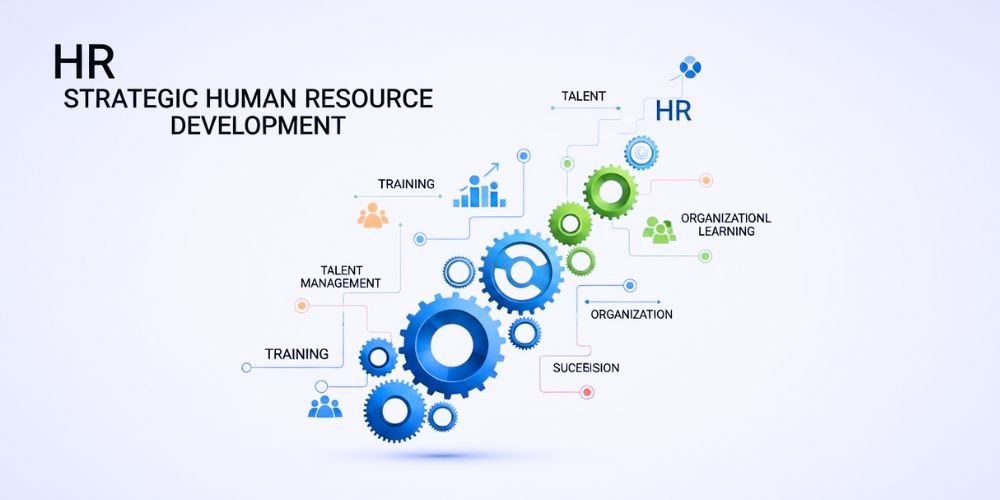In the dynamic and competitive business landscape, organizations recognize the critical role of their human resources in driving innovation, productivity, and sustainable growth. Strategic human resource development (SHRD) is vital in aligning the workforce’s capabilities with organizational goals and fostering a culture of continuous learning and development. This article delves into strategic human resource development, its key components, and its transformative impact on organizational success.
Understanding Strategic Human Resource Development
Strategic human resource development involves aligning human resource practices with an organization’s strategic objectives. It focuses on nurturing and developing the workforce’s skills, knowledge, and capabilities to meet present and future organizational needs. SHRD encompasses various initiatives, including talent acquisition, training and development, performance management, succession planning, and career development. By strategically investing in human capital, organizations can enhance their competitive advantage, drive innovation, and adapt to evolving market dynamics.
Key Components of Strategic Human Resource Development
To achieve success in human resource development, it is important to understand the key components of strategic HRD.
Talent Acquisition and Recruitment
Strategic human resource development begins with effective talent acquisition and recruitment practices. Organizations need to identify the required skills and competencies for specific roles and attract top talent that aligns with the organization’s strategic objectives. By implementing strategic recruitment strategies, leveraging employer branding, and adopting innovative hiring practices, organizations can ensure the acquisition of high-potential employees who will contribute to the long-term success of the organization.
Training and Development
Training and development initiatives are at the core of strategic human resource development. Organizations must provide employees with opportunities to enhance their skills, knowledge, and capabilities through targeted training programs, workshops, mentorship, and e-learning platforms. By investing in employee development, organizations foster a culture of continuous learning, adaptability, and innovation while equipping employees with the necessary tools to contribute effectively to the organization’s strategic goals.
Performance Management
Strategic human resource development involves implementing effective performance management processes. It includes setting clear performance expectations, establishing key performance indicators (KPIs), and providing regular feedback and coaching to employees. By aligning individual goals with organizational objectives, performance management ensures that employees’ efforts contribute directly to the organization’s success. Regular performance assessments and performance-based rewards and recognition programs motivate employees and drive continuous improvement.
Succession Planning and Talent Management
Strategic human resource development encompasses succession planning and talent management to ensure a pipeline of future leaders and critical organizational roles. Organizations can build a strong talent bench that can fill key positions when needed by identifying high-potential employees and providing them with targeted development opportunities. Succession planning mitigates the risks associated with leadership gaps and ensures the organization’s long-term stability and sustainability.
Career Development and Employee Engagement
Strategic human resource development focuses on fostering employee engagement and career development. Organizations should provide employees with clear career paths, growth opportunities, and challenging assignments. By offering career development programs, mentorship, and coaching, organizations can enhance employee satisfaction, increase retention, and attract top talent. Engaged employees who see opportunities for growth and advancement are more likely to contribute positively to the organization’s success.
Data-driven Decision-Making
Strategic human resource development relies on data-driven decision-making to assess the impact of HR practices on organizational outcomes. Organizations should leverage HR analytics and metrics to measure talent acquisition effectiveness, training and development programs, performance management, and succession planning initiatives. By gathering and analyzing data, organizations can make informed decisions, identify areas for improvement, and align HR practices with organizational goals more effectively.
Impact of Strategic Human Resource Development on Organizational Success
These components of strategic HRD are essential for organizations to attract, retain, and develop the best talent while aligning their HR initiatives with their overall business strategy.
Increased Organizational Agility
Strategic human resource development enables organizations to adapt to rapidly changing market conditions and industry disruptions. By nurturing a skilled and adaptable workforce, organizations can respond quickly to emerging challenges, seize opportunities, and remain competitive in dynamic environments.
Enhanced Employee Performance and Engagement
Effective human resource development practices enhance employee performance and engagement. Employees who feel valued and supported through training, development, and career advancement opportunities are more likely to be motivated, productive, and committed to achieving organizational goals.
Improved Succession Planning and Leadership Development
Strategic human resource development ensures the availability of future leaders within the organization. Organizations can build a strong leadership pipeline and ensure a smooth transition of critical roles by identifying high-potential employees and providing targeted development opportunities.
Attraction and Retention of Top Talent
Organizations that invest in strategic human resource development become attractive employers. When employees see opportunities for growth, career advancement, and skill development, they are more likely to join and stay with the organization, reducing turnover and attracting top talent.
Cultivation of a Learning Culture
Strategic human resource development fosters a learning culture within the organization. Organizations create an environment encouraging innovation, creativity, and continuous improvement by providing ongoing learning opportunities and promoting knowledge sharing.
Conclusion
Strategic human resource development is a critical element in achieving organizational success. By aligning HR practices with strategic objectives, organizations can acquire and develop talent, nurture employee engagement, build leadership pipelines, and foster a culture of continuous learning. Strategic human resource development empowers organizations to adapt to changing market dynamics, enhance employee performance, and drive innovation. As organizations recognize the importance of human capital, investing in strategic human resource development becomes imperative for long-term success in today’s dynamic business environment.













